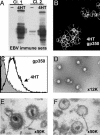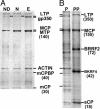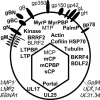Proteins of purified Epstein-Barr virus
- PMID: 15534216
- PMCID: PMC528973
- DOI: 10.1073/pnas.0407320101
Proteins of purified Epstein-Barr virus
Abstract
Mature Epstein-Barr virus (EBV) was purified from the culture medium of infected lymphocytes made functionally conditional for Zta activation of lytic replication by an in-frame fusion with a mutant estrogen receptor. Proteins in purified virus preparations were separated by gradient gel electrophoresis and trypsin-digested; peptides were then analyzed by tandem hydrophobic chromatography, tandem MS sequencing, and MS scans. Potential peptides were matched with EBV and human gene ORFs. Mature EBV was mostly composed of homologues of proteins previously found in a herpes virion. However, EBV homologues to herpes simplex virus capsid-associated or tegument components UL7 (BBRF2), UL14 (BGLF3), and EBV BFRF1 were not significantly detected. Instead, probable tegument components included the EBV and gamma-herpesvirus-encoded BLRF2, BRRF2, BDLF2 and BKRF4 proteins. Actin was also a major tegument protein, and cofilin, tubulin, heat shock protein 90, and heat shock protein 70 were substantial components. EBV envelope glycoprotein gp350 was highly abundant, followed by glycoprotein gH, intact and furin-cleaved gB, gM, gp42, gL, gp78, gp150, and gN. BILF1 (gp64) and proteins associated with latent EBV infection were not detected in virions.
Figures




References
-
- Davison, A. J. & Taylor, P. (1987) J. Gen. Virol. 68, 1067-1079. - PubMed
-
- de Jesus, O., Smith, P. R., Spender, L. C., Elgueta Karstegl, C., Niller, H. H., Huang, D. & Farrell, P. J. (2003) J. Gen. Virol. 84, 1443-1450. - PubMed
-
- Davison, A. J., Dargan, D. J. & Stow, N. D. (2002) Antiviral Res. 56, 1-11. - PubMed
Publication types
MeSH terms
Substances
Grants and funding
LinkOut - more resources
Full Text Sources
Other Literature Sources

